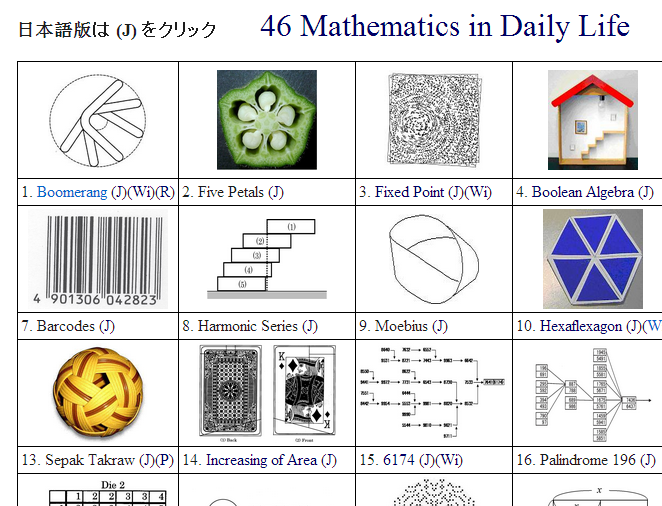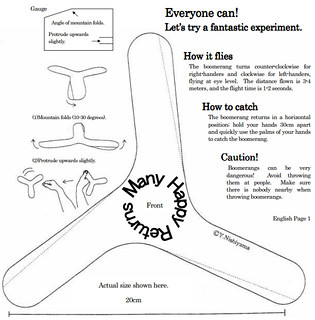1001 Leaders: Make and fly boomerangs with Yutaka Nishiyama
Professor Yutaka Nishiyama(西山豊) seeks mathematics in everyday life and in cultural traditions. How does an egg roll down a slope? Why do French, Japanese, and Indian people count on their fingers in such different ways? Why do boomerangs fly? Yutaka finds out through research so playful you can follow it with your kids. I love how his accessible explorations mix childlike curiosity, the DIY spirit of making, the scientific experiments – and global sharing. In 1999-2007, The International Boomerang Project for world peace translated instructions for making simple paper boomerangs into 70 languages, making it accessible to 99.99% of the world’s population.

Photo: Yutaka Nishiyama with a variety of boomerangs, 1992
In our 1001 Circles series, we feature math circles stories from the point of view of a circle leader, who acts as an invisible tour guide. In the companion series 1001 Leaders, we put the spotlight on the leaders themselves. What got them started and what keeps them going? What are their math dreams and worries? If you lead a math circle, an engineering club, or an informal playgroup, we would like to hear your story or interview you. Write moby@moebiusnoodles.com to talk about your adventures. Here is the interview Prof. Yutaka Nishiyama gave for the series. When Yutaka works with kids and adults from all over the world, the activities center on simple curiosity about objects from the daily life. Try this technique with your kids!
How did you start working on mathematics? How did you get interested in topics such as boomerangs and direction of writing in different languages?
When I was young, I liked math – or rather, I needed math, like I needed eating. I studied math earlier than my friends did, and I was bored with math textbooks at school, and with my math schoolteachers.
Math is hidden everywhere in the daily life, but nobody notices it. I have always enjoyed finding interesting math themes in the daily life. Most people might say that the boomerang is about physics or aerodynamics, not math, and direction of writing is about linguistics, not math. For me, whatever I feel or think is math, or can be math. There is Math of Egg Shapes, Math of Fans, Math of Languages and so on. Math is unlimited! We, teachers and kids, have to go out from math textbooks and into the world.
I started to ask questions about boomerangs when I was 10 years old, and started to study Math of Boomerangs at 30, in 1978. In the summer of 1978, it was very hot. I had blinds on the windows, and researched blinds in an encyclopedia. The article about boomerangs happened to be on the same page. It brought back questions I had at 10, and I felt studying boomerangs would be more interesting than studying blinds.
To spread the word about fantastic boomerangs all over the world, I wanted to translate instructions for making boomerangs into 70 native languages. English is a common language, but only 20% of world people can read it. After translations into 70 languages, my interest changed from the Math of Boomerangs to the Math of Languages. How do the ways languages evolved relate to the ways people write? This theme is very exciting for me.

Picture: a screenshot from Yutaka Nishiyama’s site. His new book includes the first thirty articles from this collection – The Mysterious Number 6174: One of 30 Mathematical Topics in Daily Life.
What activity can a family or a math circle do with children, about their native language and math?
Almost all people in the world only know their native language, and believe their language is correct and excellent. Ask kids what is the correct direction of writing. They are likely to answer about their native language. Then you can discuss how there are hundreds of languages on this Earth, and knowing different languages and cultures is useful for world peace. English is written left to right, Arabic right to left, but which is correct? There is no right answer for that question!
In our upcoming book Bright, Brave, Open Minds by Julia Brodsky, there are dozens of “Aha!” problems that sound easy, but lead to wise or funny insights. Yutaka Nishiyama’s simple question, “What is the correct direction of writing?” is a great example of an easy task that leads into deep insights. – Maria D.

In the Boomerang Project kids learn to make their own boomerangs. How can kids experiment and play around? What variations and variables can they try?
For kids, paper boomerangs are easy to make and safe to fly. Here are some variations:
- Make two copies of the same boomerang and glue them together. How far will that double boomerang fly, compared to the single?
- Make holes at the end of wings. You can hear the whistle. Try different holes.
- Make alphabetical boomerangs, in shapes of letters from A to Z, or the first letter of your name. Whose boomerangs can return the best? X or Y return well, but I does not. O is stable to fly but does not return so well, and so on.
Related Posts
Posted in A Math Circle Journey, Make







Thank you for my interview.
next news are maybe by those who read this interview.
I wish paper boomerangs spreading all over the world for world peace.
Return to Sender, October 21, 2014
http://www.futilitycloset.com/2014/10/21/return-to-sender-3/
WATCH: This cool, little, paper boomerang and make your own! Oct 22, 2014, facebook
https://www.facebook.com/boingboing/posts/10152432238856179
Mini indoor boomerang, Oct 22, 2014
http://www.eastlondonforum.com/viewtopic.php?f=14&t=19451
Rainy Weekend Fun – Make a Paper Boomerang for Indoor Throwing, Oct 24, 2014
http://www.mcminvestigations.com/blog/
Haciendo un boomerang, Oct 22th, 2014
http://millenio.wordpress.com/2014/10/22/haciendo-un-bumerang/
Make this nifty indoor boomerang, Oct 21th, 2014, Spanish
http://news.silobreaker.com/make-this-nifty-indoor-boomerang-5_2268313618468569088
How to make Sepak Takraw Ball:
https://www.youtube.com/watch?v=d6UOrn48dRE